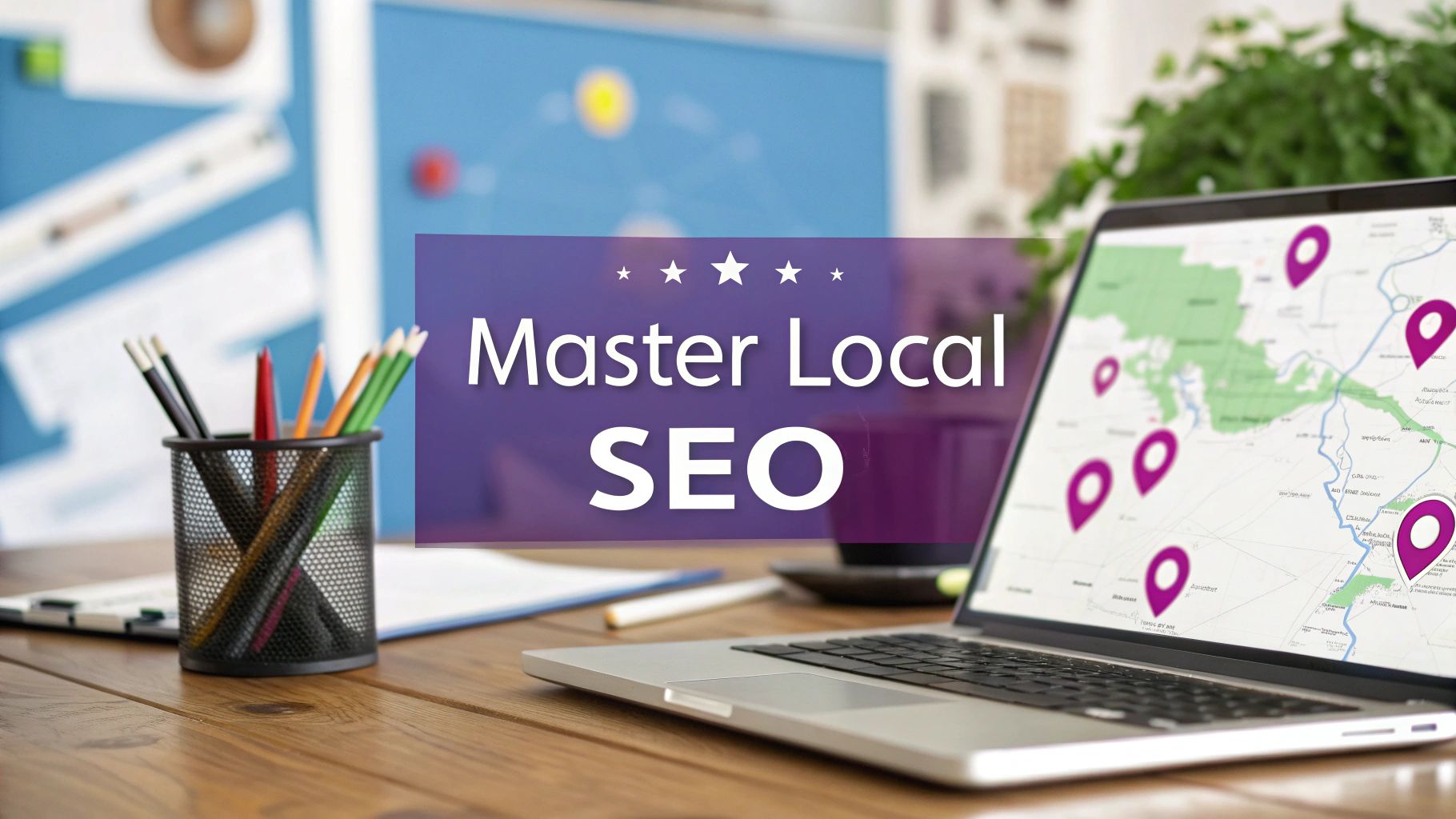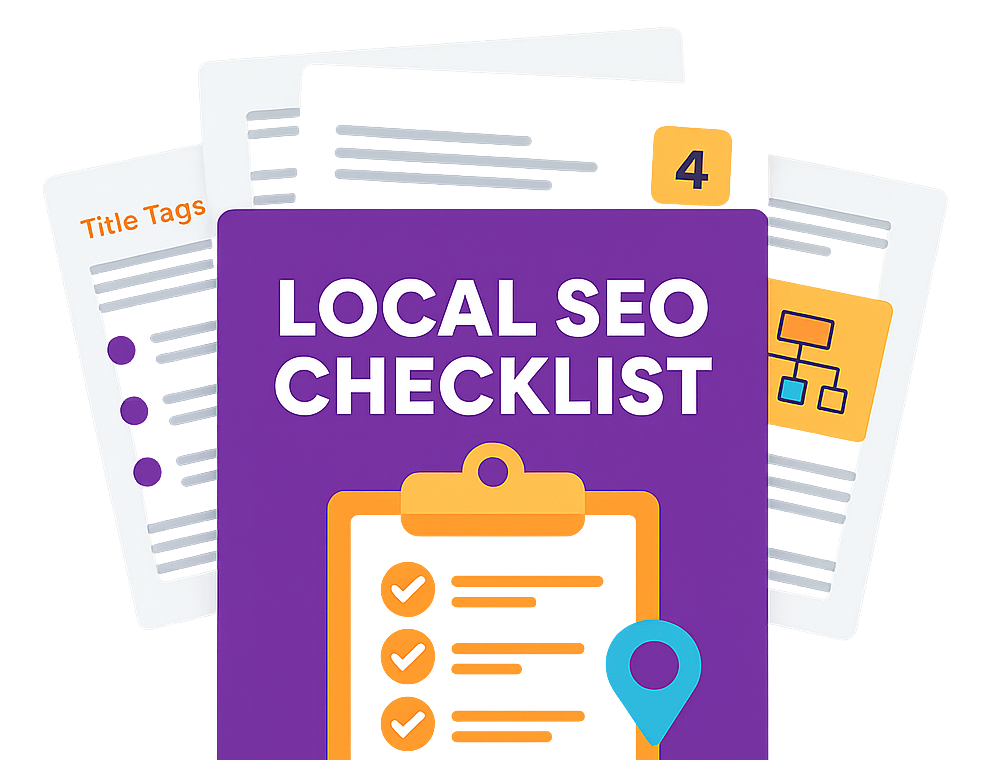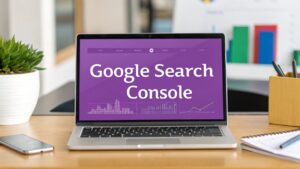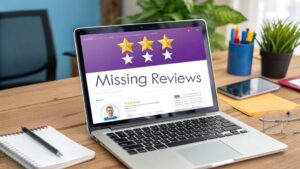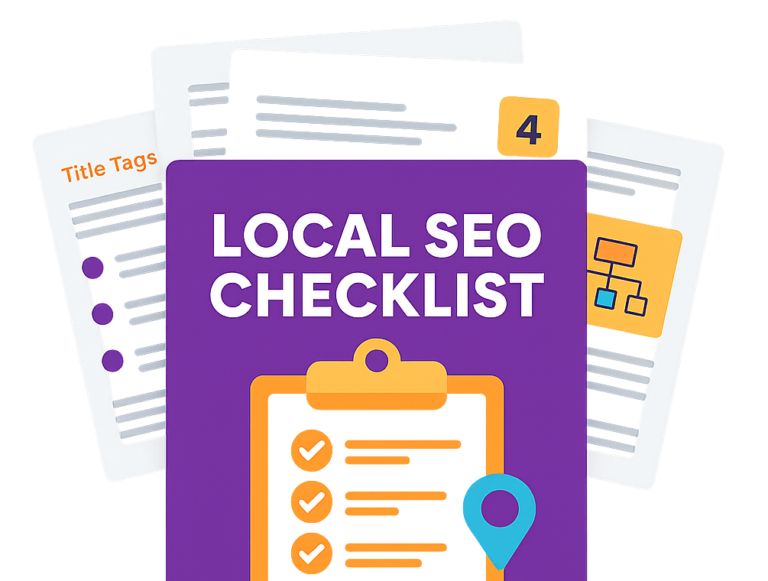Ever wondered how Google magically picks the top three businesses when you search for "coffee shop near me"? It's not magic, but it is a pretty clever system. Google's goal is to mimic how you’d find the best local spot in the real world—by weighing up reputation, relevance, and how close it is.
This system is built on three core pillars: Relevance, Distance, and Prominence. These are the foundations of all local search ranking factors.
Getting your head around these principles first is a game-changer. It gives you the "why" behind every specific action you’ll take later, from tweaking your website to asking for reviews. Think of it as learning the rules of the game before you try to score.
The Three Pillars of Local Rankings
Google's local algorithm is all about giving users the most helpful and trustworthy results. To do that, it sizes up every local business against three fundamental criteria.
Here’s a simple breakdown of what Google is looking for when it ranks local businesses.
Google's Three Pillars of Local Search Explained
| Pillar | What It Means for Your Business | Key Action |
|---|---|---|
| Relevance | How well does your business actually match what the user is looking for? | Fill out your Google Business Profile completely, especially your business category and services. |
| Distance | How physically close is your business to the person searching? | Ensure your address is accurate on your GBP and consistent everywhere online. |
| Prominence | How well-known and respected is your business in the local community (both online and off)? | Actively gather customer reviews and build mentions on other local websites and directories. |
These three pillars work together to determine who gets the top spots. Let's dig into each one a bit more.
Relevance
This pillar answers a simple question: "Is this business a good fit for what the user wants?" Google scans the information you provide—especially your primary business category and the list of services on your Google Business Profile—to figure this out. If someone searches for "emergency plumber," Google looks for plumbers who explicitly list that as a service. The content on your website plays a big part here, too.
Distance (Proximity)
This one is the most straightforward. It's all about how far your business is from the searcher's location or the location they typed into their search (e.g., "solicitors in Cambridge"). If a user is physically standing in central Cambridge, businesses closer to them will naturally have an edge for that search. Simple as that.
Prominence
Prominence is all about how well-known your business is. Think of it as your digital reputation. Google measures this by looking at signals from all over the web, including:
- The number and quality of your customer reviews.
- Local backlinks from other reputable local websites.
- Mentions in well-regarded online directories.
A business with a strong, positive online footprint is seen as more prominent and, therefore, more trustworthy in Google's eyes.
Prominence is basically Google’s version of word-of-mouth. A business with heaps of great reviews and mentions online is effectively being recommended by the digital community, making it a much safer bet for searchers.
This diagram shows you the main areas you need to focus on to start influencing these pillars.

As you can see, the most direct way to beef up your local search performance is by nailing your Google Business Profile, sorting out your on-page SEO, and getting a steady stream of customer reviews.
For UK businesses, building prominence through local directories is a particularly powerful move. Why? Because UK business directories provide strong geographic and authority signals through consistent Name, Address, and Phone number (NAP) information, which Google absolutely loves for local rankings.
Another technical trick up your sleeve is Schema. To help search engines get a crystal-clear picture of your business's relevance and location, learning why schema markup is important for SEO can give you a serious advantage.
Optimising Your Google Business Profile to Win

Your Google Business Profile (GBP) isn't just another online directory listing; it's your digital shopfront. Honestly, it's the single most powerful local search ranking factor you have complete control over and the absolute foundation of your local visibility.
When you get it right, your GBP transforms from a static business card into a machine that brings real-world customers through your door.
A well-managed profile is your ticket to the coveted Google Map Pack—that block of three local businesses sitting pretty at the top of the search results. For most local businesses, landing a spot here is the endgame. It grabs most of the clicks and the lion's share of the attention.
The Power of Your Primary Category
When you set up your profile, the first choice you make is also the most critical: your primary business category. This one selection tells Google exactly what you do. It's not just a small detail; it's a massive ranking signal.
Think about it this way: out of all the factors Google looks at, your primary GBP category has the biggest say in your Map Pack ranking. In fact, research shows that Google Business Profile signals as a whole influence about 32% of local pack rankings.
With 42% of UK users clicking on those Map Pack results, getting this right is non-negotiable.
Choosing the wrong primary category is like putting a sign for a bakery on the front of a butcher's shop. You're just confusing everyone, especially Google. You must pick the one category that perfectly sums up your core business. You can add secondary categories later for your other services, but your primary one carries all the weight.
Completing Every Section Matters
An incomplete profile is a wasted opportunity. Simple as that.
Google rewards businesses that give them detailed, thorough information because it helps them serve up better, more reliable results to searchers. A fully fleshed-out profile screams trustworthiness and authority.
Treat your GBP like a living, breathing tool, not a set-it-and-forget-it listing. Your goal should be to fill out every single section.
- Business Description: Write a compelling, keyword-rich description that explains who you are, what you offer, and what makes you the best choice.
- Services and Products: Don't be shy. List every service you provide and every product you sell. This is how you start ranking for specific searches like "emergency boiler repair in Cambridge."
- Photos and Videos: Keep it fresh. Regularly upload high-quality pictures of your work, your team, and your premises. Visuals build trust and get people to engage.
- Business Hours: This seems basic, but so many get it wrong. Keep your opening times, including special holiday hours, perfectly accurate. Nothing frustrates a potential customer faster than showing up to a closed door.
A complete Google Business Profile is like a well-lit, clearly signed shop. It invites customers in by giving them all the information they need upfront, making them feel confident in their choice to engage with you.
To get every last detail perfect, you might want to check out our complete guide to Google Business Profile optimisation.
Engaging with Customers Through GBP Features
Beyond the basic info, your GBP is packed with powerful tools for engaging directly with your audience. These aren't just nice-to-haves; they are active ranking signals. They show Google your business is active, responsive, and valued by the local community. Use them consistently, and you'll gain a serious edge over the competition.
Google Posts
Think of Google Posts as free ad space right on your profile. Use them to shout about special offers, share company news, or highlight a new product. Posting regularly keeps your profile looking fresh and tells Google you're an active business—a huge plus for your rankings. Each post is also another chance to work in relevant keywords.
The Q&A Section
The Questions & Answers section is gold. It lets potential customers ask you things directly on your listing. You need to keep a close eye on this and provide quick, helpful answers. Better yet, get ahead of the game. Add your own frequently asked questions and answer them yourself to build out a handy FAQ section.
Managing Reviews
Customer reviews are one of the most powerful local search ranking factors within your GBP. They provide undeniable social proof and have a direct impact on how prominently you appear.
Actively encourage your happy customers to leave reviews. And, crucially, respond to every single one—good or bad. A thoughtful reply to a negative review can often win over more future customers than a dozen five-star ratings. A steady stream of recent, positive reviews is a clear signal to Google that you're a trusted local authority.
Google Business Profile Optimisation Checklist
To help you stay on track, we've put together a simple checklist. Work through these points to ensure your profile is in top shape and ready to compete for those top spots in the local pack.
| Optimisation Area | Why It's Important | Status |
|---|---|---|
| Verify Your Listing | The essential first step. An unverified profile won't show up in local search results. | |
| Primary Category | The single biggest ranking factor. Must accurately reflect your core business. | |
| NAP Consistency | Your Name, Address, and Phone number must be identical everywhere online to build trust. | |
| Complete All Sections | A full profile signals authority to Google and gives customers confidence. | |
| Add High-Quality Photos | Visuals increase engagement and help customers see what you offer. | |
| List All Services/Products | Allows you to rank for specific, high-intent searches from ready-to-buy customers. | |
| Utilise Google Posts | Keeps your profile fresh, active, and provides opportunities for keyword placement. | |
| Manage Q&A Section | Proactively answering questions builds trust and provides valuable information. | |
| Encourage & Manage Reviews | Strong social proof and a key ranking signal. Respond to every review. | |
| Enable Messaging | Gives customers another easy way to connect with you directly from your profile. |
Ticking off every item on this list puts you in a fantastic position. A fully optimised profile is a powerful asset that works for you 24/7, driving calls, website visits, and foot traffic.
Connecting Your Website and Physical Location
In local SEO, your website and your physical location are two halves of the same whole. For Google to feel confident sending nearby searchers your way, it needs to see a crystal-clear connection between your digital footprint and your real-world address. Think of it as leaving a digital trail of breadcrumbs that leads straight from a search query to your front door.
This whole process starts with a factor you can’t really control, but absolutely have to understand: proximity.
The Unbeatable Power of Proximity
Proximity is just a fancy word for how close your business is to the person searching. Simple, right? If someone in central Cambridge searches for an “emergency locksmith,” Google’s first job is to show them the nearest, most relevant options. It's the digital version of glancing down the high street to see what’s open.
This factor is so powerful it often trumps everything else. You could have a stunning website and hundreds of five-star reviews, but if you're ten miles away from the searcher, a closer (and maybe less-optimised) competitor could still beat you in the Map Pack.
For businesses in the UK, the proximity between a searcher and the business is one of the most critical local ranking factors. Google uses your address and the searcher's location data to figure out who's most relevant. Even being a few miles out can push you down the list. Learn more about the nuances from these insights on local ranking factors on directiveconsulting.com.
You can't just pick up your shop and move it closer to every potential customer. What you can do is strengthen every other signal you send to Google, making sure you’re the undeniable best choice for anyone within your service area. This is where your website’s on-page SEO really comes into play.
Weaving Your Location into Your Website
Your website needs to consistently signal to Google where you operate and who you serve. This isn’t about clumsy keyword stuffing; it’s about strategically placing location details where they feel natural to both users and search engines.
Get started with these core on-page actions:
- Title Tags and Headers: Your page titles and H1 headers are prime real estate. A generic "Our Services" page is a missed opportunity. Instead, go for something like "Professional Plumbing Services in Cambridge." It instantly tells Google the what and the where.
- Service and Product Descriptions: Weave location-based keywords naturally into your main content. For instance, "As a family-run electrician serving the wider Cambridgeshire area, we specialise in…"
- Contact and About Us Pages: Your full Name, Address, and Phone number (NAP) should be clear and easy to find. We’ll dive into why NAP consistency is so vital in a later section.
A well-optimised website acts as a digital anchor for your physical location. Every mention of your service area reinforces your local relevance, making it easier for Google to connect you with nearby customers who need your help.
Creating Dedicated Location Pages
Does your business serve multiple distinct areas or have more than one physical branch? If so, you absolutely need dedicated pages for each location. A single "locations" page listing addresses just won't cut it if you want to compete effectively in each area.
Each location page needs to be a unique, genuinely useful resource for local customers.
- Unique Content: Don't just copy and paste content and swap out the city name. Write original descriptions. Mention local landmarks, talk about challenges specific to that community, and showcase testimonials from local clients.
- Specific NAP Details: Make sure the unique Name, Address, and Phone number for that particular branch are displayed clearly.
- Embedded Google Map: Embed a Google Map showing the precise pin for that branch. This creates a powerful, direct signal linking your website to your Google Business Profile.
- Local Schema Markup: Use local business schema on each page. This gives search engines neatly structured data about that location's hours, address, and services.
Of course, all this work relies on a website that's well-maintained and technically sound. Following robust content management system best practices ensures your site’s foundation is solid and ready to support all these crucial location-specific pages.
Building Your Local Authority and Trust

While your Google Business Profile is your digital shopfront, Google is always looking for outside opinions to figure out how prominent your business really is. It wants to see that you’re a known and respected name in your local area, both online and in the real world. This is where you build genuine authority and trust.
Think of it like getting a recommendation from a trusted neighbour. When other reputable online sources mention your business, it’s a powerful vote of confidence that tells Google you’re the real deal.
Two of the best ways to build this online reputation are through local citations and backlinks. They might sound similar, but they play very different—and equally vital—roles in your local SEO.
Citations: The Foundation of Local Trust
A local citation is any online mention of your business’s Name, Address, and Phone number (NAP). You’ll find these everywhere, from big UK directories like Yell and Thomson Local to smaller, niche-specific listing sites.
Their main job is to prove you’re consistent. When Google sees the exact same NAP details for your business across dozens of reliable websites, it becomes certain that your business is legitimate and your information is correct. This consistency is a cornerstone of the local search ranking factors.
On the flip side, inconsistent or wrong information just creates confusion and chips away at Google's trust, which can directly sink your rankings.
Backlinks: The Mark of Local Authority
A backlink, on the other hand, is when another website actively links to yours. A citation just lists your details, but a backlink is an endorsement. It’s another site owner essentially saying, “This business is so valuable, I’m willing to send my own visitors over to them.”
Of course, not all backlinks are created equal. A link from the local newspaper’s website, a popular community blog, or a local business partner carries serious weight. These kinds of links signal to Google that you’re not just a business that exists—you’re an authoritative and respected part of the local community.
Citations are about being listed; backlinks are about being recommended. You need consistent listings to build a foundation of trust and quality recommendations to establish yourself as a local leader.
Building a Powerful Citation Profile
Getting your citations in order is a methodical process. It’s all about checking what’s already out there, fixing the mistakes, and then building new, high-quality listings.
- Audit Your Current Citations: First, you need to find out where your business is already listed. It’s amazing how often errors creep in, especially if you’ve moved or changed a phone number over the years.
- Clean Up Inconsistencies: Hunt down any variations of your business name, old addresses, or wrong phone numbers. Once you find them, you'll need to contact the directory owners to get them corrected. This clean-up job is absolutely critical for building trust with Google.
- Build New Citations: Systematically get your business listed on reputable UK directories. Focus on quality over quantity. Start with the major national players before moving on to industry-specific and city-specific sites.
Doing this all by hand can be a real time-sink. Using some of the best local SEO tools can help you audit, clean, and build citations far more efficiently.
Earning Valuable Local Backlinks
Earning backlinks isn’t about filling out forms; it’s about building relationships and creating genuine value within your community. This takes a bit more creativity and a proactive approach.
Here are a few practical ideas to get you started:
- Sponsor a Local Event: Getting behind a local charity fun run, a school fete, or a community festival nearly always gets you a backlink from the event organiser’s website.
- Partner with Other Local Businesses: Team up on a project or offer a reciprocal discount with a non-competing local business. This often leads to natural mentions and links on each other's websites.
- Create a Local Resource: Write a genuinely useful blog post like "The Ultimate Guide to Dog-Friendly Pubs in Cambridge" or "A Calendar of Local Farmers' Markets." This kind of content naturally attracts links from community blogs and local news sites.
- Engage with Local Press: Got some interesting business news to share? Or perhaps you can offer an expert opinion on a local issue? Getting a feature in the local newspaper or an online publication is a brilliant way to earn a high-authority backlink.
Using Reviews and Customer Actions as Ranking Signals

Technical optimisation gets your business on the map, sure, but it’s the human element that really moves the needle. Google pays incredibly close attention to how real people interact with your business online, using their actions as powerful signals of trust. This is where your reputation and customer behaviour come into play.
Think of it like a high street. A shop with a queue outside and a buzz of happy chatter is naturally going to look more popular and trustworthy than an empty one. Online, that chatter is your reviews, and the queue is all the little actions customers take on your profile.
The Power of Online Reviews
Reviews are one of the most direct ways Google can gauge how good your business is. They’re pure social proof, and they influence both potential customers and the search algorithms themselves. But it’s not just about racking up five-star ratings.
Google looks at several things when it analyses your reviews:
- Quantity: A lot of reviews suggests you’re an established business that’s served plenty of people.
- Velocity: How often are you getting new reviews? A steady stream of recent feedback shows you’re active and relevant right now.
- Sentiment: Google's clever enough to understand the language used in reviews. Positive words and mentions of your services reinforce that you’re a good match for what people are searching for.
- Diversity: Reviews across multiple platforms—like Google, Yelp, or industry-specific sites—paint a much fuller picture of your reputation.
To get a handle on customer sentiment, a great starting point is measuring customer satisfaction. If you know what makes your customers tick, you’re in a much better position to encourage that positive feedback.
A business that actively encourages and responds to all reviews—good and bad—sends a massive signal to Google. It shows you value customer feedback and are committed to great service. That engagement is a ranking factor all on its own.
Understanding Behavioural Signals
Beyond what people write, Google also watches what they do. These are called behavioural signals, and they’re clear-cut indicators of how popular your business is in the real world. When users constantly interact with your listing, it tells Google you're a genuinely helpful local resource.
Each of these actions is like a vote of confidence, directly impacting your spot in the local pack.
Key behavioural signals to watch for include:
- Click-Through Rate (CTR): How many people actually click on your listing when they see it? A high CTR means your profile is doing a good job of grabbing attention.
- Requests for Directions: This one’s huge. When someone clicks the "Directions" button, it’s a massive signal they intend to visit you in person.
- Phone Calls: Clicks on your phone number straight from your Google Business Profile are a primary conversion for most local businesses.
- Website Visits: If people are clicking through from your profile to your website, it shows they’re interested and want to learn more.
A listing that generates a high volume of these interactions is basically proving its worth to Google. It’s the digital equivalent of a busy shop, signalling that your business is a popular and relevant choice. Your goal is to make your profile so complete and engaging that taking one of these actions feels like the natural next step for anyone who finds you.
How to Measure and Improve Your Local SEO Performance
A great local SEO strategy is never really “done.” It’s a constant cycle of tweaking, measuring, and adapting to stay ahead of the competition. If you want to keep your business visible, you have to make decisions based on cold, hard data—not just guesswork.
Think of it like checking your shop’s accounts. You wouldn’t just guess if you were profitable; you’d look at the sales figures and expenses. In the same way, tracking your local SEO performance is the only way to know what’s actually working and where you need to put more effort. It’s about understanding how your online presence turns into real-world customers walking through your door.
Key Metrics to Monitor
To get a proper sense of your local SEO health, you need to keep an eye on a few specific metrics. These numbers tell the story of how local customers are finding you and what they do once they do. Flying blind isn't an option.
Here are the essential performance indicators you should be watching:
- Map Pack Rankings: Are you showing up in that all-important top-three box for your main keywords? This is prime digital real estate and a massive goal for any local campaign.
- Local Organic Traffic: How many people are landing on your website from location-based searches? A steady climb here is a great sign that your on-page work is paying off.
- GBP Interactions: Keep a close eye on clicks for phone calls, direction requests, and website visits coming directly from your Google Business Profile. These are high-intent actions from people ready to engage.
- Conversion Rate: Of all the local searchers who find you, how many are actually taking that final step, like booking an appointment or making a purchase?
Essential Tools for Tracking Performance
You don’t need to break the bank on fancy software to get started. Google actually gives you a couple of incredibly powerful—and free—tools that provide all the insights you need.
Your Google Business Profile Insights and Google Search Console are your two best friends in local SEO. They give you a direct window into how customers find your business and how Google sees your website’s authority for local searches.
For a complete picture, it’s a smart move to include social media analytics reporting alongside your core SEO metrics. And to make sure you're covering all your bases, our comprehensive local SEO checklist provides a clear, structured plan to tackle all the critical local search ranking factors. Following a system makes measuring your success a whole lot easier.
Frequently Asked Questions
How Long Does It Take to See Local SEO Results?
It's the question everyone asks, but the honest answer is: it depends. Generally speaking, you should start to see some real movement in your local rankings within three to six months.
What makes the timeline shift? Things like how competitive your industry is, your specific location, and how consistently you’re working on it. If you get the fundamentals right—like a fully optimised Google Business Profile and consistent business citations—you can see results on the quicker side. But for the big, long-lasting wins, like earning powerful local backlinks, you need to play the long game.
What Is the Difference Between Local SEO and Organic SEO?
Think of it like this: organic SEO is about casting a wide net to catch customers nationally or even globally. Local SEO, on the other hand, is like using a highly targeted fishing rod to catch customers right in your own neighbourhood.
Local SEO is all about showing up for searches like 'best coffee shop in Bristol' or when someone just types 'plumber near me' into their phone.
While both share the same DNA—things like on-page optimisation and link building—local SEO has its own unique rulebook. It puts a huge emphasis on specific local search ranking factors like your Google Business Profile, making sure your business details are consistent everywhere online, and how close you are to the person searching.
Can I Do Local SEO Without a Physical Shopfront?
Yes, absolutely. If you’re a plumber, an electrician, or any other business that travels to your customers, you’re what’s known as a service-area business (SAB). Local SEO is just as critical for you.
When you set up your Google Business Profile, you simply tell Google the areas you serve instead of listing a physical address. Your strategy will still be about proving you’re a local expert. That means creating content on your website for the specific towns or neighbourhoods you cover, getting local business listings, and, most importantly, gathering reviews from customers within your service area. It all helps you show up when someone nearby needs exactly what you offer.
At Bare Digital, we cut through the noise and turn these complex ranking factors into a clear, straightforward growth strategy. Our specialist SEO services are built to get your Cambridgeshire business in front of the right local customers. Ready to see what's possible? Get your free, no-obligation SEO audit today. Find out more at https://www.bare-digital.com.

